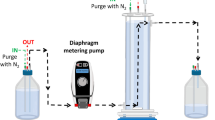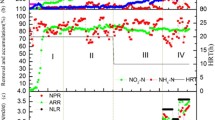Abstract
A nitrifying consortium was kinetically, stoichiometrically and molecularly characterized via the in situ pulse respirometric method and pyrosequencing analysis before and after the addition of m-cresol (25 mg C L−1) in a sequencing batch reactor (SBR). Five important kinetic and stoichiometric parameters were determined: the maximum oxygen uptake rate, the maximum nitrification rate, the oxidation yield, the biomass growth yield, and the substrate affinity constant. An inhibitory effect was observed in the nitrification process with a recovery of this by up to eight SBR cycles after m-cresol was added to the system. However, full recovery of the nitrification process was not observed, as the maximum oxygen uptake rate was 25% lower than that of the previous operation without m-cresol addition. Furthermore, the pyrosequencing analyses of the nitrifying consortium after the addition of only two pulses of 25 mg C L−1 m-cresol showed an important microbial community change represented by a decrease in the nitrifying populations and an increase in the populations degrading phenolic compounds.





Similar content being viewed by others
References
Amor L, Eiroa M, Kennes C, Veiga MC (2005) Phenol biodegradation and its effect on the nitrification process. Water Res 39:2915–2920. doi:10.1016/j.watres.2005.05.019
APHA (1998) Standard methods for the examination of water and wastewater, 20th edn. American Public Health Association, Washington, DC
Autenrieth RL, Bonner JS, Akgerman A, Okaygum M, McCreary EM (1991) Biodegradation of phenolic wastes. J Hazard Mater 28:29–53
Boll M, Löffler C, Morris BEL, Kung JW (2014) Anaerobic degradation of homocyclic aromatic compounds via arylcarboxyl-coenzyme A esters: organisms, strategies and key enzymes. Environ Microbiol 16:612–627. doi:10.1111/1462-2920.12328
Ebie Y, Noda N, Miura H, Matsumura M, Tsuneda S, Hirata A (2004) Comparative analysis of genetic diversity and expression of amoA in wastewater treatment process. Appl Microbiol Biotechnol 64:740–744. doi:10.1007/s00253-004-1558-x
Esquivel-Rios I, Ramirez-Vargas R, Hernandez-Martinez GR, Vital-Jacome M, Ordaz A, Thalasso F (2014) Microrespirometric method for the determination of stoichiometric and kinetic parameters of heterotrophic and autotrophic cultures. Biochem Eng J 83:70–78. doi:10.1016/j.bej.2013.12.006
Gan HM, Chew TH, Tay YL, Lye SF, Yahya A (2012) Genome sequence of Hydrogenophaga sp. strain PBC, a 4-aminobenzenesulfonate-degrading bacterium. J Bacteriol 194:4759–4760. doi:10.1128/JB.00990-12
Heipieper HJ, Loffeld B, Keweloh H, de Bont JAM (1995) The Cis/Trans isomerisation of unsaturated fatty acids in Pseudomonas putida S12: an indicator for environmental stress due to organic compounds. Chemosphere 30:1041–1051. doi:10.1016/0045-6535(95)00015-Z
Hu M, Wang X, Wen X, Xia Y (2012) Microbial community structures in different wastewater treatment plants as revealed by 454-pyrosequencing analysis. Bioresour Technol 117:72–79. doi:10.1016/j.biortech.2012.04.061
Hyman MR, Sansome-Smith AW, Shears JH, Wood PM (1985) A kinetic study of benzene oxidation to phenol by whole cells of Nitrosomonas europaea and evidence for the further oxidation of phenol to hydroquinone. Arch Microbiol 143:302–306
Isken S, Santos PMAC, de Bont JAM (1998) Bacteria tolerant to organic solvents. Extremophiles 2:229–238
Islam MS, Zhang Y, McPhedran KN, Liu Y, El-Din MG (2015) Next-Generation pyrosequencing analysis fo microbial biofilm communities of granular activated carbon in treatment of oil sands process-affected water. Appl Environ Microbiol 81:4037–4048. doi:10.1128/AEM.04258-14
Jayamani I, Cupples AM (2015) Stable isotope probing and high-throughput sequencing implicate Xanthomonadaceae and Rhodocyclacea in ethylbenzene degradation. Environ Eng Sci 32:240–249. doi:10.1089/ees.2014.0456
Jemaat Z, Suarez Ojeda ME, Perez J, Carrera J (2014) Sequentially alternating pollutant scenarios of phenolic compounds in a continuous aerobic granular sludge reactor performing simultaneous partial nitritation and o-cresol biodegradation. Bioresour Technol 161:354–361. doi:10.1016/j.biortech.2014.03.071
Keener WK, Arp DJ (1993) Kinetic studies of ammonium monooxygenase inhibition in Nitrosomonas europaea by hydrocarbons and halogenated hydrocarbons in an optimized whole-cell assay. Appl Environ Microbiol 59:2501–2510
Kishimoto N, Kosako Y, Tano T (1991) Acidobacterium capsulatum gen. nov., sp. nov.: an acidophilic chemoorganotrophic bacterium containing menaquinone from acidic mineral environment. Curr Microbiol 22:1–7
Kuenen JG, Robertson LA (1994) Combined nitrification–denitrification processes. FEMS Microbiol Rev 15:109–117
Liu Z, Frigaard NU, Vogl K, Lino T, Ohkuma M, Overman J, Bryant DA (2012) Complete genome of Ignavibacterium album, a metabolically versatile, flagellated, facultative anaerobe from the phylum Chlorobi. Front Microbiol 3:1–15. doi:10.3389/fmicb.2012.00185
Lobo CC, Bertola NC, Contreras EM (2013) Stoichiometry and kinetic of the aerobic oxidation of phenolic compounds by activated sludge. Bioresour Technol 136:58–65. doi:10.1016/j.biortech.2013.02.079
Lowry OH, Rosenbrough NJ, Farr AL, Randall RJ (1951) Protein measurement with the Folin phenol reagent. J Biol Chem 193:265–275
Lu L, Xing D, Ren N (2012) Pyrosequencing reveals highly diverse microbial communities in microbial electrolysis cells involved in enhanced H2 production from waste activated sludge. Water Res 46:2425–2434. doi:10.1016/j.watres.2012.02.005
Martínez-Hernández S, de María Texier AC, Cuervo-López F, Gómez J (2011) 2-Chlorophenol consumption and its effect on the nitrifying sludge. J Hazard Mater 185(2–3):1592–1595. doi:10.1016/j.jhazmat.2010.09.100
McCarty GW (1999) Review article: modes of action of nitrification inhibitors. Biol Fertil Soils 29:1–9
McKenzie N, Yue S, Liu X, Ramsay BA, Ramsay JA (2014) Biodegradation of naphthenic acids in oils sands process waters in an immobilized soil/sediment bioreactor. Chemosphere 109:164–172. doi:10.1016/j.chemosphere.2014.02.001
Milia S, Cappai G, Perra M, Carucci A (2012) Biological treatment of nitrogen-rich refinery wastewater by partial nitritation (SHARON) process. Environ Technol 33:1477–1483. doi:10.1080/09593330.2012.660651
Monsalvo VM, Mohedano AF, Casas JA, Rodríguez JJ (2009) Cometabolic biodegradation of 4-chlorophenol by sequencing batch reactors at different temperatures. Bioresour Technol 100:4572–4578. doi:10.1016/j.biortech.2009.04.044
Morita M, Kudo N, Uemoto H, Watanabe A, Shinozaki H (2007) Protective effect of immobilized ammonia oxidizers and phenol-degrading bacteria on nitrification in ammonia- and phenol-containing wastewater. Eng Life Sci 7:587–592. doi:10.1002/elsc.200700014
Müller JA, Galushko AS, Kappler A, Schink B (1999) Anaerobic degradation of m-cresol by Desulfobacterium cetonicum is initiated by formation of 3-hydroxybenzyl-succinate. Arch Microbiol 172:287–294
Ordaz A, Oliveira CS, Aguilar R, Carrión M, Ferreira EC, Alves M, Thalasso F (2008) Kinetic and stoichiometric parameters estimation in a nitrifying bubble column through “in situ” pulse respirometry. Biotechnol Bioeng 100:94–102. doi:10.1002/bit.21723
Ordaz A, Oliveira CS, Quijano G, Ferreira EC, Alves M, Thalasso F (2012) Kinetic and stoichiometric characterization of a fixed biofilm reactor by pulse respirometry. J Biotechnol 157:173–179. doi:10.1016/j.jbiotec.2011.10.015
Pramparo L, Suárez-Ojeda MA, Pérez J, Julián Carrera (2012) Kinetics of aerobic biodegradation of dihydroxybenzenes by a p-nitrophenol-degrading activated sludge. Bioresour Technol 110:57–62. doi:10.1016/j.biortech.2012.01.071
Ramirez-Vargas R, Ordaz A, Carrion M, Hernandez-Paniagua IY, Thalasso F (2013) Comparison of static and dynamic respirometry for the determination of stoichiometric and kinetic parameters of a nitrifying process. Biodegradation 24:675–684. doi:10.1007/s10532-012-9615-0
Rojas-Herrera R, Narváez-Zapata JA, Zamudio-Maya M, Mena-Martínez ME (2008) A simple silica-based method for metagenomic DNA extraction from soil and sediments. Mol Biotechnol 40:13–17. doi:10.1007/s12033-008-9061-8
Saravanan P, Pakshirajan K, Saha P (2009) Batch growth kinetics of an indigenous mixed microbial culture utilizing m-cresol as the sole carbon source. J Hazard Mater 162:476–481. doi:10.1016/j.jhazmat.2008.05.069
Sikkema J, de Bont JAM, Poolman B (1995) Mechanisms of membrane toxicity of hydrocarbons. Microbiol Rev 59:201–222
Silva CD, Gomez J, Houbron E, Cuervo-Lopez FM, Texier AC (2009) p-Cresol biotransformation by a nitrifying consortium. Chemosphere 75:1387–1391. doi:10.1016/j.chemosphere.2009.02.059
Silva CD, Gomez J, Beristain-Cardoso R (2011) Simultaneous removal of 2-chlorophenol, phenol, p-cresol and p-hydroxybenzaldehyde under nitrifying conditions: kinetic study. Bioresour Technol 102:6464–6468. doi:10.1016/j.biortech.2011.03.105
Silva CD, Beristain-Montiel L, Cuervo-López FM, Texier AC (2014) p-Cresol mineralization and bacterial population dynamics in a nitrifying sequential batch reactor. J Environ Sci 26:1885–1893. doi:10.1016/j.jes.2014.06.033
Strauss EA, Mitchell NL, Lamberti GA (2002) Factors regulating nitrification in aquatic sediments: effects of organic carbon, nitrogen availability, and pH. Can J Fish Aquat Sci 59:554–563. doi:10.1139/F02-032
Sun W, Li Y, McGuinness LR, Luo S, Huang W, Kerkhof LJ, Mack EE, Häggblom MM, Fennell DE (2015) Identification of anaerobic analine-degrading bacteria at a contaminated industrial site. Environ Sci Technol 49:11079–11088. doi:10.1021/acs.est.5b02166
Takenaka S, Nomura R, Minegishi A, Yoshida KI (2013) Enrichment and characterization of a bacterial culture that can degrade 4-aminopyridine. BMC Microbiol 13:1471–2180. doi:10.1186/1471-2180-13-62
Talbot G, Topp E, Palin MF, Massé DI (2008) Evaluation of molecular methods used for establishing the interactions and functions of microorganisms in anaerobic bioreactors. Water Res 42:513–537. doi:10.1016/j.watres.2007.08.003
Texier AC, Gomez J (2007) Simultaneous nitrification and p-cresol oxidation in a nitrifying sequencing batch reactor. Water Res 41:315–322. doi:10.1016/j.watres.2006.10.017
Tsitko IV, Zaitsev GM, Lobanok AG, Salkinoja-Solonen MS (1999) Effect of aromatic compounds on cellular fatty acid composition of Rhodococcusopacus. Appl Environ Microbiol 65:853–855
Vásquez I, Rodríguez J, Marañón E, Castrillón L, Fernández Y (2006) Simultaneous removal of phenol, ammonium and thiocyanate from coke wastewater by aerobic biodegradation. J Hazard Mater 137:1773–1780. doi:10.1016/j.jhazmat.2006.05.018
Veeresh GS, Kumar P, Mehrotra I (2005) Treatment of phenol and cresol upflow anaerobic sludge blanket (UASB) process: a review. Water Res 39:154–170. doi:10.1016/j.watres.2004.07.028
Wang X, Hu M, Xia Y, Wen X, Ding K (2012) Pyrosequencing analysis of bacterial diversity in 14 wastewater treatment systems in China. Appl Environ Microbiol 78:7042–7047. doi:10.1128/AEM.01617-12
Wittebolle L, Vervaeren H, Verstraete W, Boon N (2008) Quantifying community dynamics of nitrifiers in functionally stable reactors. Appl Environ Microbiol 74:286–293. doi:10.1128/AEM.01006-07
Zepeda A, Ben-Youssef C, Rincón S, Cuervo-López F, Gómez F (2013) Complete and simultaneous removal of ammonium and m-cresol in a nitrifying sequencing batch reactor. Biodegradation 24:377–385. doi:10.1007/s10532-012-9595-0
Acknowledgements
This work was supported by CONACYT (169563).
Author information
Authors and Affiliations
Corresponding author
Electronic supplementary material
Below is the link to the electronic supplementary material.
Rights and permissions
About this article
Cite this article
Ordaz, A., Sánchez, M., Rivera, R. et al. Respirometric response and microbial succession of nitrifying sludge to m-cresol pulses in a sequencing batch reactor. Biodegradation 28, 81–94 (2017). https://doi.org/10.1007/s10532-016-9779-0
Received:
Accepted:
Published:
Issue Date:
DOI: https://doi.org/10.1007/s10532-016-9779-0




